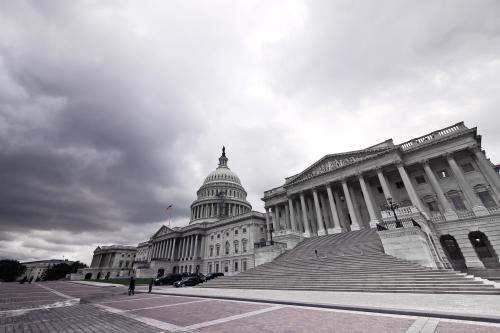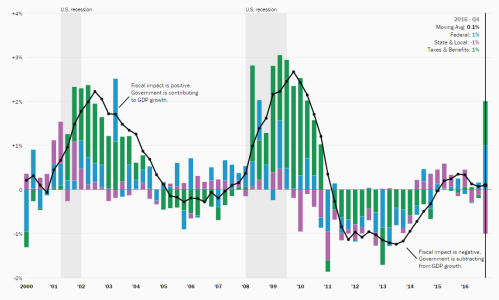Introduction
In light of recent economic trends and the most recent Congressional Budget Office projections,1 we offer new estimates of the medium- and long-term fiscal outlook, updating our previous work, most recently by Auerbach and Gale.2
The basic story has two components. First, federal non-interest spending and revenues are out of balance, generating persistent primary deficits that are sizable given the near-full-employment assumptions. Second, net interest payments rise steadily and substantially relative to GDP due to high pre-existing debt, persistent primary deficits, and gradually increasing interest rates. Together, these two patterns generate rising unified deficits and public debt as a share of GDP.
Under current law for the next 10 years, CBO’s projections imply that primary deficits will average 2.1% of GDP. Net interest payments will rise from 3.1% of GDP to 4.1% in 2035, which would represent an all-time high. Both the unified deficit and the cyclically-adjusted deficit average about 6% of GDP over this period. Debt will rise from 98% of GDP at the end of 2024 to 118% by 2035, another all-time high.
Over the following two decades, the projected trends are even less auspicious. Sizable primary deficits persist indefinitely. The average nominal interest rate on government debt rises to exceed the nominal economic growth rate by 2046, setting off the possibility of explosive debt dynamics. By 2055, relative to GDP, annual net interest payments reach 5.4%, the unified deficit reaches 7.0%, and the public debt stands at 154%. All these figures would be all-time highs (except for deficits during World War II, the 2008 financial crisis, and in the first two years of the COVID-19 pandemic) and would continue to grow after 2055.
Budget outcomes would be even worse under “current-policy” projections that incorporate more realistic policy choices than those required by the baseline calculations. Making temporary tax provisions—such as those in the Tax Cut and Jobs Act of 2017—permanent would raise the 2055 debt ratio to 195%. In addition, making plausible assumptions about future discretionary spending to maintain current services per capita in domestic spending and maintain real outlays in defense would drive the debt-to-GDP ratio to 209% by 2055. However, we emphasize both that, at the moment, it is difficult to discern what a “current policy” scenario should look like and that our assumptions about how current policy differs from current law are probably conservative—that is, they probably understate the extent of likely policy interventions and understate future deficits. President Trump has endorsed a plethora of additional tax cuts, and some tax increases and the spending trajectory are equally uncertain.3
Fiscal gap calculations indicate the magnitude of the changes required to meet a future fiscal target. For example, starting from the current-law baseline, we estimate that to keep the debt-to-GDP ratio at its 2024 level (98%) in 2055 would require a combination of permanent spending cuts or tax increases equaling 1.84% of GDP if implemented starting in 2026. This represents about $530 billion, or about 22% of 2024 income tax revenues, 11% of all tax revenues, 9% of non-interest spending, or 15% of non-interest spending other than Social Security and Medicare. Delaying the implementation of the actions would raise the size of the intervention needed.
While the fiscal situation is problematic, it bears emphasis that the outlook has improved since CBO’s previous projections, largely because of upward GDP revisions, which in turn lead to higher projected taxable income and individual income tax receipts.4 For example, under the current-law projections: The projected debt-GDP ratio in 2034 fell from 122% in June 2024 to 117% in January 2025; the projected debt-GDP ratio in 2054 fell from 179% to 152%; and the fiscal gap—the adjustments required to maintain the current debt-GDP ratio in 30 years—fell from 2.65% of GDP to 1.84%. Long-term budget projections, of course, are sensitive to parameter choices in general and to interest rate projections in particular. But even with the improvement in the long-term outlook, it would take enormous and unlikely favorable variation from baseline parameters to put fiscal policy on a sustainable course in the absence of major policy changes.
Section II describes the construction of different budget baselines. Section III summarizes how projections for gross domestic product (GDP) and interest rates have changed over the past year. Section IV examines the 10- and 30-year current-law budget projections as of January 2025 and compares them to the June 2024 baseline. Section V estimates the effects of current-policy adjustments relative to current law. Section VI discusses cyclically-adjusted deficits and sensitivity analysis. Section VII calculates fiscal gaps under various scenarios. Section VIII concludes with a discussion of a variety of perspectives on and interpretations of the budget outlook.
-
Acknowledgements and disclosures
The authors thank Ian Berlin and Oliver Hall for research assistance and Joshua Gotbaum for helpful comments. Gale thanks Arnold Ventures and the California Community Foundation for generous research support.
-
Footnotes
- CBO, “The Budget and Economic Outlook: 2025 to 2035” (January 17, 2025).
- Alan J. Auerbach and William G. Gale, “The Sound of Silence: Ignoring the U.S. Fiscal Problem,” Tax Notes Federal (September 9, 2024).
- In a February 6, 2025, posting by the White House on X, the president is said to endorse—in addition to TCJA extension, which is described as “renewing the Trump Tax Cuts”—eliminating income taxes on tips, seniors’ Social Security, and overtime pay; adjusting the SALT cap; eliminating special tax breaks for “billionaire sports team owners,” taxing carried interest; and cutting taxes for products that are made in America. https://x.com/WhiteHouse/status/1887631465648681364. Of course, the president has endorsed a variety of tariffs as well. For revenue effects of these and other alternatives, see https://www.crfb.org/blogs/trump-tax-priorities-total-5-11-trillion.
- CBO, supra note 1.
The Brookings Institution is committed to quality, independence, and impact.
We are supported by a diverse array of funders. In line with our values and policies, each Brookings publication represents the sole views of its author(s).







